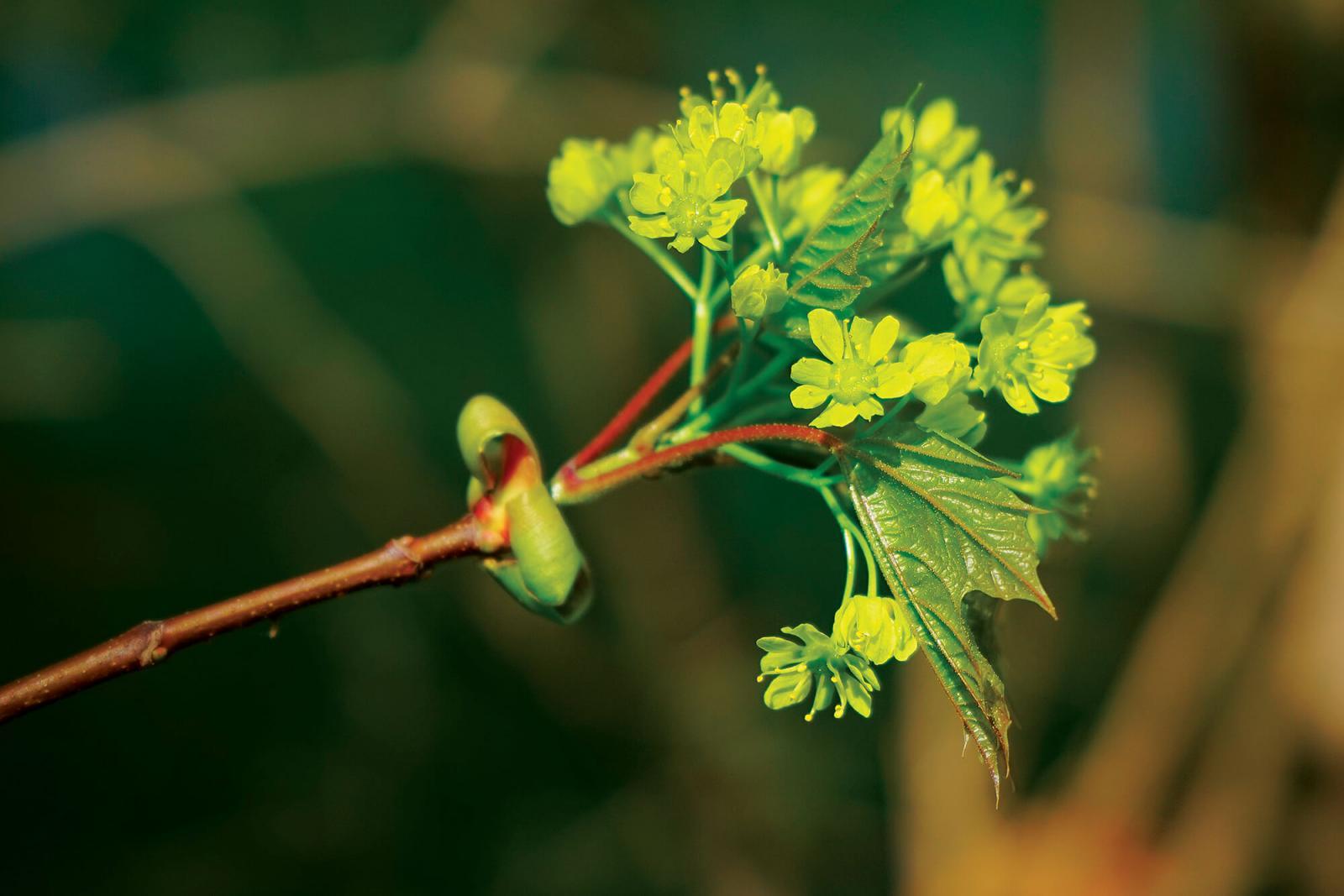October 23, 2014

Acer flower bud.
Plant healthy landscapes ... and breathe easier
BY PETER PRAKKE AND SEAN JAMESRates of allergy affliction have been rising, depriving people of outdoor enjoyment. We want people to enjoy landscapes! Many of our most allergenic plants used in urban landscapes are trees, both native and non-native. Yews are also huge pollen producers. The big problem is that more and more often, the public defines a perfect tree as one that drops no fruit and is ‘clean.’ As a result, nurseries are growing male clones of tree species almost exclusively. This has caused increased pollen in our cities and a corresponding increase in asthma suffering.
It used to be that cities were planted with American elm, Ulmus americana, which supported biodiversity, providing early nectar for bees and other pollinators. Unfortunately, it was favoured over most other trees forming a near-monoculture. When Dutch elm disease came along, it swept through our cities, destroying much of the canopy. Elms are pollinated by insects and, as such, don’t have wind-borne pollen that causes allergic reactions. The trees chosen to replace the elms included those which produce a lot of pollen but were not messy and litter-free, such as male ash, maples and monoecious trees, especially oak species and sycamore.
Many rippling effects happened because of the switch from the elms to other tree species. In addition to allergy increases, there were other negative environmental consequences from overuse of male clones. The elm flowers were a rich nectar source and bloomed very early in the season, when other food sources for insects were limited. Honeybees and butterflies depended on that food source. This depletion of an early-season food source was one factor contributing to a decline in honeybees and butterflies.
Nature is always highly diverse, and biodiversity is the way to go when we are creating landscapes that will limit allergenic exposure. We need to avoid falling into the rut of using the same plants repeatedly. Pollen allergies today are far worse in the urban areas than in the country. When residential areas are professionally landscaped with the same plant material used over and over again, and then repeated on commercial landscapes as well, we all lose — unhappy customers in the long run and unhappy passers-by, who should be able to enjoy their environs with a minimum of discomfort. Our urban landscapes require a diversity of species, but also a diversity of genders — female and male plants.
The sex of the plant is one factor that contributes to allergies and asthma; others are:
- Duration of bloom
Certain grasses, shrubs and trees may produce allergenic pollen for only two or three days per year, while others may release pollen intermittently for several months. - Weight of the pollen
Some grains are heavy and will not fall far from the tree while others are light and float easily in the wind. Wind-borne pollen causes most allergy and asthma problems. - Moisture level of the pollen
Sticky, moist pollen often clings to an element close to the source, while dry pollen floats and lands on any available moist surface, such as the mucus membranes of your nose and mouth. Perhaps the whole business of tidy landscapes has gotten out of control. Our desire to manipulate nature is starting to backfire on us. Using native species is good, but it’s worth considering that manipulation of their sexes for the purpose of low-maintenance planting is becoming an unhealthy situation.
Is there a link between climate change and allergies/asthma? There certainly is, and it makes it increasingly important to start using OPALS, the Ogren Plant Allergy Scale, in plant, shrub and tree selection.
Healthy schoolyards equal healthy children. Female plants clean up pollen as natural pollen traps and serve as air filters. Using allergy friendly-rated native and non-native plants will reduce the incidence of exposure and the severity of local allergies and asthma. The Hamilton-Wentworth Catholic School Board and the Hamilton-Wentworth District School Board in Hamilton, Ont., are taking the lead in implementing the OPALS scale in their landscape planning. Arborists, landscapers and designers should pay heed and shift toward creation of the urban development that is healthy for everyone, including all who suffer from breathing disorders such as allergies or asthma. In this case, the resource we are managing is the very air we breathe. Clean, fresh air is priceless. Be a champion of change — create healthier natural environments using allergy-friendly plants, and make biodiversity and ecological/environmentally responsible decisions in your landscapes. With emerald ash borer, we’re losing the seedless ash. Admittedly, this is terrible in so many ways BUT we have an opportunity to avoid the same old mistakes. To investigate the OPALS philosophy, visit safegardening.org.
Peter Prakke is a horticultural communicator and educator in Ancaster, Ont.
Sean James is owner of an Ontario-based environmentally-conscious landscape design/build/maintenance company, an eco-consultant and a popular speaker.